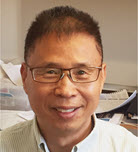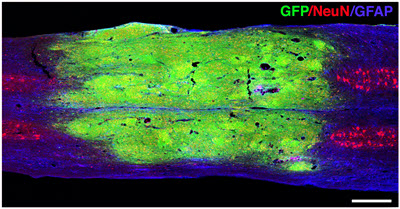
Paul Lu, Ph.D.
Associate Adjunct Professor

- Current Research
- Selected Publications
Current Research
Dr. Paul Lu received his Ph.D. in molecular biology from the University of California – Davis, and performed his post-doctoral research in the laboratory of Dr. Mark Tuszynski at the University of California – San Diego (UCSD). Dr. Lu then joined the faculty of University of California, San Diego, and is currently an Associate Adjunct Professor of Neuroscience and a Research Health Science Specialist at the Veterans Administration San Diego Healthcare System. Dr. Lu’s research focuses on neural stem cells to form new neural relay circuits after spinal cord injury. Dr. Lu’s work aims to “splice” the injured neural circuit by implanting neural stem cells into sites of spinal cord injury. These implanted cells survive transplantation to the injury site, mature into neurons and glia, and send out literally hundreds of thousands of new connections into the damaged spinal cord. Injured neurons of the host nervous system regenerate into the stem cell transplants, forming neural connections. In this way, the injured spinal cord can form new relay circuits through the injury to partially restore function. While much basic work remains to be done with this neural repair strategy, Dr. Lu and his colleagues hope to translate this work eventually into humans with spinal cord injury.

Excellent survival, integration and maturation of grafted neural progenitor cells (NPCs) in a rat T10 moderate contusive injury site
GFP, NeuN, and GFAP labeling show survival, complete filling, and maturation of transplanted embryonic day 14-derived multipotent NPC expressing GFP in a contusive lesion cavity. NeuN is a mature neuronal marker and GFAP is an astroglia marker. Scale Bar: 550 μm.
Selected Publications
1. Rosenzweig ES, Brock JH, Lu P, Kumamaru H, Salegio EA, Kadoya K, Weber JL, Liang JJ, Moseanko R, Hawbecker S, Huie JR, Havton LA, Nout-Lomas YS, Ferguson AR, Beattie MS, Bresnahan JC, Tuszynski MH. 2018. Restorative effects of human neural stem cell grafts on the primate spinal cord. Nat Med. 2018 Feb 26. doi: 10.1038/nm.4502. [Epub ahead of print]
2. Dulin JN, Adler AF, Kumamaru H, Poplawski GHD, Lee-Kubli C, Strobl H, Gibbs D, Kadoya K, Fawcett JW, Lu P, Tuszynski MH. 2018. Injured adult motor and sensory axons regenerate into appropriate organotypic domains of neural progenitor grafts. Nat Commun. 9(1):84.
3. Lu P, Ceto S, Wang Y, Graham L, Wu D, Kumamaru H, Staufenberg E and Tuszynski MH. 2017. Prolonged human neural stem cell maturation supports recovery in injured rodent CNS. J Clin Invest, 127(9):3287-3299.
4. Robinson J and Lu P. 2017. Optimization of trophic support for neural stem cell grafts in sites of spinal cord injury. Exp Neurol, 291:87-97.
5. Kadoya K, Lu P, Nguyen K, Lee-Kubli C, Kumamaru H, Yao L, Knackert J, Poplawski G, Dulin JN, Strobl H, Takashima Y, Biane J, Conner J, Zhang SC, Tuszynski MH. 2016. Spinal cord reconstitution with homologous neural grafts enables robust corticospinal regeneration. Nat Med. 22(5):479-87.
6. Lu P, Woodruff G, Wang Y, Graham L, Wu D, Poplawski G, Brock J, Goldstein L, and Tuszynski T. 2014. Long-distance axonal growth of neural stem cells derived from human induced pluripotent stem cells after spinal cord injury. Neuron, 83(4):789-96.
7. Hou S, Tom VJ, Graham L, Lu P, Blesch A. 2013. Partial restoration of cardiovascular function by embryonic neural stem cell grafts after complete spinal cord transection. J Neurosci. 33(43):17138-49.
8. Lu, P, Wang Y, Graham, L, McHale A.K., Gao M, Wu D, Brock, J, Blesch, A, Rosenzweig E, Havton L, Zheng B, Conner J, Marsala M and MH. Tuszynski. 2012. Long-distance growth and connectivity of neural stem cells after severe spinal cord injury. Cell 150(6):1264-73.
9. Lu P, Blesch A, Graham L, Wang Y, Samara R, Banos K, Haringer V, Havton L, Weishaupt N, Bennett D, Fouad K, Tuszynski MH. 2012 Motor axonal regeneration after partial and complete spinal cord transection. J Neurosci. 32(24):8208-18.
10. Kadoya K, Tsukada S, Lu P, Coppola G, Dan Geschwind D, Filbin M, Blesch A and Tuszynski M. 2009. Combined Intrinsic and Extrinsic Neuronal Mechanisms Facilitate Bridging Axonal Regeneration One Year after Spinal Cord Injury. Neuron 64:165-172.
11. Schachtrup C, Lu P, Jones LL, Lee JK, Lu J, Sachs BD, Zheng B, Akassoglou K. 2007. Fibrinogen inhibits neurite outgrowth via beta 3 integrin-mediated phosphorylation of the EGF receptor. Proc Natl Acad Sci U S A. 104(28):11814-9.
12. Lu, P., H. Yang, L. Jones, M. T. Filbin and M. Tuszynski. 2004. Combinatorial therapy with neurotrophins and cAMP promotes axonal regeneration beyond sites of spinal cord injury. J. Neurosci. 24: 6402-6409.
13. Lu, P., A. Blesch and M. Tuszynski. 2001. Neurotrophism without neurotropism: BDNF promotes survival but not growth of lesioned corticospinal neurons. J. Comp. Neurol. 436: 456-470.
Click here for a list of all my publications
